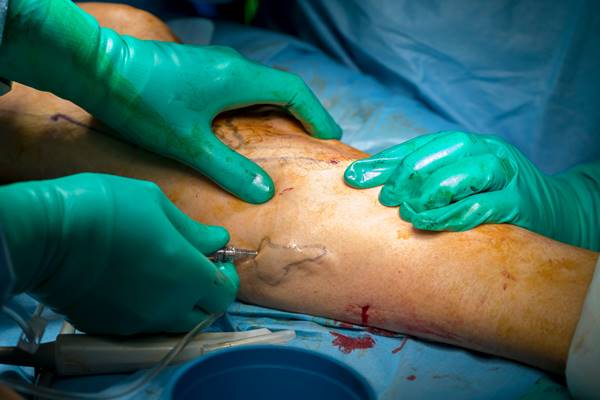Chronic venous insufficiency (CVI) refers to a medical condition characterized by the impaired functioning of the veins in the legs, resulting in inadequate blood flow back to the heart. This chronic condition occurs when the valves within the veins become damaged or weakened, hindering their ability to effectively pump blood against gravity. There are several causes that contribute to the development of CVI.

The most common cause is deep vein thrombosis (DVT), where blood clots form within deep veins and obstruct blood flow. Other factors include obesity, pregnancy, prolonged standing or sitting, and a sedentary lifestyle. Varicose veins, which are abnormally enlarged and twisted superficial veins, can also lead to CVI if left untreated. Over time, CVI can cause symptoms such as leg swelling, pain, heaviness or fatigue.
Symptoms and Diagnosis of Chronic Venous Insufficiency
Symptoms of chronic venous insufficiency (CVI) can vary depending on the severity of the condition. Common symptoms include leg swelling, especially in the ankles and lower legs, which may worsen after prolonged standing or sitting. Patients may experience aching or heaviness in their legs, accompanied by a sensation of throbbing or cramping. Additionally, CVI can cause skin changes such as discoloration, dryness, and itching. In advanced cases, open sores or ulcers may develop on the affected leg.
Diagnosing CVI involves a comprehensive evaluation that includes a physical examination and medical history review. The doctor will assess any visible signs of vein abnormalities and perform tests to measure blood flow in the veins. Doppler ultrasound is commonly used to evaluate blood flow and detect any blockages or reflux in the veins. This non-invasive imaging technique helps determine the extent of venous insufficiency and aids in treatment planning.
Risk Factors for Chronic Venous Insufficiency
Chronic venous insufficiency (CVI) is a condition that occurs when the valves in the veins of the legs fail to properly pump blood back to the heart. While CVI can affect anyone, certain factors increase the risk of developing this condition.
One significant risk factor is age. As individuals grow older, their veins may lose elasticity and weaken, making it harder for blood to flow efficiently.
Another contributing factor is gender, as women are more prone to CVI due to hormonal changes during pregnancy and menopause.
Obesity also plays a role in CVI development. Excess weight puts added pressure on the veins, hindering proper blood circulation.
Similarly, a sedentary lifestyle can contribute to CVI by reducing muscle contraction and impairing venous return.
Other risk factors include a family history of vein problems, smoking, and occupations that require prolonged standing or sitting.
Complications Associated with Chronic Venous Insufficiency
Chronic venous insufficiency (CVI) can lead to various complications, which may significantly impact a person’s quality of life.
One common complication is the development of varicose veins, which are enlarged and twisted veins that often cause discomfort, pain, and swelling in the affected area.
Additionally, CVI can cause skin changes such as dermatitis, characterized by redness, itching, and inflammation.
In severe cases, chronic venous ulcers may develop due to poor blood circulation and increased pressure within the affected veins. These ulcers typically occur around the ankles or lower legs and are difficult to heal without proper treatment.
Furthermore, CVI increases the risk of deep vein thrombosis (DVT), a potentially life-threatening condition where blood clots form in deep veins.
Treatment Options for Chronic Venous Insufficiency
The treatment of chronic venous insufficiency (CVI) aims to relieve symptoms, prevent complications, and improve overall venous circulation.
Conservative management includes lifestyle modifications such as regular exercise, weight reduction, and elevating the legs above heart level to alleviate symptoms like swelling and pain.
Compression therapy using elastic stockings or bandages is commonly recommended to improve blood flow by applying pressure on the veins.
In more severe cases or when conservative measures fail, medical interventions may be necessary.
Endovenous thermal ablation techniques like laser or radiofrequency ablation can be performed to close off diseased veins and redirect blood flow.
Surgical procedures like vein ligation and stripping are less common but may be considered in specific situations.
Newer minimally invasive approaches like foam sclerotherapy or ambulatory phlebectomy have also shown promising results in treating CVI.
Lifestyle Changes to Manage Chronic Venous Insufficiency
Managing chronic venous insufficiency (CVI) often involves making certain lifestyle changes to alleviate symptoms and prevent further complications.
Firstly, maintaining a healthy weight is crucial, as excess weight can put additional pressure on the veins and exacerbate CVI symptoms. Following a balanced diet rich in fiber can prevent obesity, which puts extra pressure on veins.
Regular exercise, such as walking or swimming, helps improve blood circulation and strengthen the leg muscles, which supports the veins in their task of transporting blood back to the heart.
maintaining a healthy weight and following a balanced diet rich in fiber can prevent obesity, which puts extra pressure on veins.
Moreover, it is important to avoid prolonged periods of sitting or standing. Individuals with CVI should try to take breaks and move around every hour or so to prevent blood from pooling in the legs. Elevating the legs above heart level for short periods throughout the day can also aid in reducing swelling and discomfort.
Additionally, wearing compression stockings is recommended as they provide external support to weakened veins and assist in preventing blood from pooling.
Avoiding tight clothing around the waist, thighs, or legs is also recommended as it can restrict circulation.